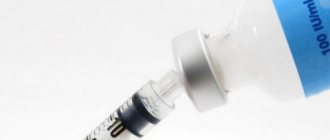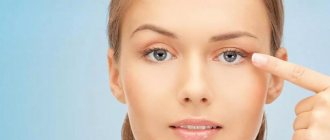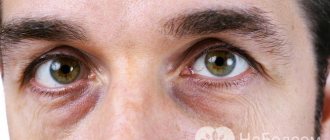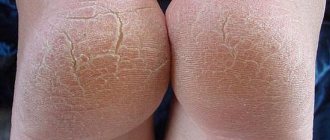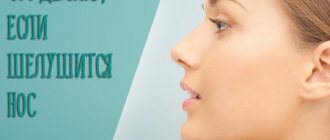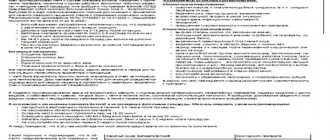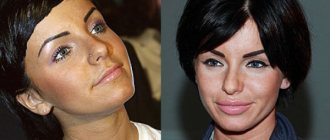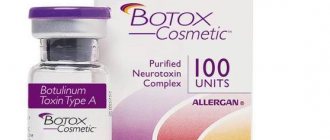Contents of the procedure
For a modern woman, this is a very convenient procedure, since the process of administering Botox does not require prior preparation. There is also no need for a recovery phase; you can immediately return to your workplace.
At the first consultation, the cosmetologist gets to know the client and determines the presence of contraindications. Listens to wishes, examines wrinkles, determines the amount of substance for injection, and sets a date for the procedure.
On the day of the session, the client should not smoke or drink strong coffee or tea in the morning. This affects the blood vessels, and they must work well. Before the injection is administered, the forehead is treated with a disinfectant. The lady is asked to frown, as she usually does. The doctor uses a special marker to mark wrinkles and puncture sites. An anesthetic gel is applied. Botox is injected into the forehead with a very thin needle; you should not look for comparisons with an ordinary subcutaneous or intramuscular injection.
After administering the drug, a cold compress is applied to all places on the forehead, which reduces discomfort and constricts blood vessels. The forehead is wiped and examined again by a cosmetologist.
The first examination is scheduled after 2 weeks. Based on the results, the doctor determines the need for correction. Although rehabilitation is not required after the procedure, in order for the effect of Botox to last long, it is necessary to behave correctly after the injection.
Taking certain types of antibiotics and antidepressants
Botox injections are contraindicated when taking antibiotics and antidepressants, the side effects of which include weakening of neuromuscular conduction. The use of such drugs has an effect similar to the effect of Botox injections - relaxation of the facial muscles, reduction in the severity of wrinkles.
Some doctors do not recommend botulinum therapy in parallel with taking antibiotics, as there is a possibility of side effects in the form of facial defects.
If botulinum toxin is administered simultaneously, two reaction options are possible:
- Excessive relaxation of muscles and the formation of various facial defects, a “waxy” face, asymmetry of muscle contraction - if the Botox injection complements the effect of the medication;
- Or, on the contrary, it is possible that the results from using Botox will decrease due to the fact that the cosmetologist, assessing muscle contraction and the severity of wrinkles, will see not the real picture, but a picture weakened by the action of the antibiotic. Therefore, if a patient actually needs to inject, say, 20 units of Botox, it may be that due to muscle relaxation caused by the drug, the esthetician will decide to inject, for example, 12 units. When the antibiotic is stopped and its effect on the muscles is completed, full muscle contraction is restored and it turns out that the Botox dosage was insufficient, and the wrinkles are largely preserved.
It is also useful to read: Botox injections in the forehead
This is true for antibiotics from the groups of aminoglycosides, macrolides, tetracyclines and lincosamides, some antidepressants and a certain set of other drugs. The list of such drugs includes more than 300 items (including blood anticoagulants), and their effect on the results of Botox injections can be different. Therefore, when coordinating the procedure with the doctor, it is necessary to inform him what medications were taken shortly before the visit or continue to be taken, and the specialist, taking this information into account, will decide on the possibility of injections.
Pros and cons (Botox has benefits and harms)
Positive points:
- Alternative.
Dysport and Botox injections are a worthy replacement for plastic surgery, so the advantage is obvious. Their activity is not such a long-term result as after plastic surgery. The best option would be to make a useful correction once a year, rather than going under a surgeon’s scalpel once every 5 years.
- Wide range of uses.
At the same time, highly purified botulinum toxin type A is used not only in cosmetology, but also in medicine for the treatment of strabismus, herpes, hyperhidrosis, toothache, etc.
- Extensive scientific research.
Botox production companies have a large number of confirmed studies that prove the integrity of the use of the drug within the stated parameters.
- Why is Botox dangerous?
The harmlessness of class A botulinum has been proven by many years of experience in using it for medicinal and cosmetic purposes. All existing unpleasant consequences in the form of disturbances in facial expression, inflammatory processes or bruises at the injection sites, as a rule, are an indication of the low qualifications of the master who performed the manipulation.
Negative points:
- The injection process is painful.
This minus is relative, relevant to those who have a low pain threshold. Usually there is no sensation, because... For injections, they use very thin needles that inject the medicine not so deeply. If necessary, specialists use light external anesthesia.
- Use only for facial folds. Botulinum toxin does not smooth out wrinkles caused by muscle tension, nor does it fight those that appear due to dry skin epidermis.
- There is no way to get rid of deep wrinkles. Such folds can be smoothed out, but they cannot be completely removed.
- If you have planned a botulinum type A procedure at home, then you should understand that the price will be very high. Choose only an experienced professional to avoid dangerous consequences.
What it is
If you ask the average person what Botox is, the most common answer will be an anti-wrinkle drug. Its fierce opponents will say that it is poison. And both will be right. Actually, “Botox” is the name of the first drug created on the basis of a type A neurotoxin, which has the ability to block the passage of nerve impulses to the muscles. Over time, it became a household name and united all means of this type.
Initially, the drug was created exclusively for medicinal purposes - it helped fight strabismus by relaxing blocked periorbital muscles. Along the way, attentive doctors noticed that the crow's feet smoothed out after its administration. Naturally, this was immediately taken into account and techniques for using it for cosmetic purposes appeared.
The idea turned out to be successful, and within a few years beauty injections confidently spread throughout the world, delighting patients with the opportunity to get rid of deep and fine expression wrinkles. Gradually many analogues appeared.
But only Dysport and Xeomin can really compete with the original Botox in terms of effectiveness and safety. The others are noticeably inferior in characteristics.
Side effects
There is always the possibility of an unsuccessful outcome. To minimize this possibility, you need to take care of choosing a certified cosmetologist, a quality product, and getting your health in order at the time of the procedure.
Side effects of Botox forehead:
- Redness in the area of skin injections.
- Formation at the injection site of a lump.
- Dryness or double vision.
- Rising temperature.
- The distribution of the substance was uneven.
- The skin of the eyelid or forehead has sagged.
- The injection site may be sore for some time after the injection.
In general, negative consequences are associated with incorrectly performed procedure techniques or the ingestion of Botox into the body. In any case, you can wait for these defects to be eliminated no earlier than several days. If the symmetry of the face was affected due to uneven distribution of the drug under the skin (for example, the skin of the forehead sagged after botulinum toxin injections), then such a failure will need to be tolerated for 3 to 5 months.
Read about how to remove Botox from your face after unwanted consequences after injections have appeared here, and from this article you will learn about why swelling occurs after Botox and how to get rid of it.
Objective indications
Only the use of Botox preparations for medical purposes for the treatment of:
- strabismus;
- facial asymmetry;
- torticollis;
- clubfoot;
- facial asymmetry;
- consequences of a stroke;
- convulsive spasms.
In cosmetology, it is widely used to prevent the deepening and smoothing of facial wrinkles and eliminate hyperhidrosis (excessive sweating).
Even when the drug is going to be injected for medicinal purposes as prescribed by a doctor, patients are warned about the possible risks associated with its use. And in a cosmetologist’s office, the client immediately assumes all responsibility, except in cases of obvious unprofessionalism, as evidenced by the signature on the paper, without which no competent doctor will carry out the procedure.
Common myths about Botox
In the process of studying information about the procedure, a person has to deal with various unreliable information
It is important to find out in advance what myths there are regarding Botox.
The effect of the drug has not been studied by doctors
Scientists first assessed the positive effects of Botox on the body in 1982. When treating blepharospasm, it was noted that botulinum toxin in the injection area helped to smooth the skin.
After receiving a similar result, cosmetologists adopted the method. Since the late 80s of the last century, it has been actively used to eliminate wrinkles.
Russian specialists did not lag behind them either. Since 1994, the method has been used in domestic cosmetology. Therefore, it cannot be called little-studied.
Botulinum toxin is a strong poison
This statement is partly true. After all, botulinum toxin really belongs to the group of strong poisons. When it enters the body, severe poisoning is observed.
However, this only applies to increased dosages of the drug. To initiate intoxication, the injection must contain one hundred times more botulinum toxin.
Some countries use the substance to treat diseases in children. However, doctors note that antibiotics can be much more dangerous than Botox.
Botox is addictive
This judgment is also partly true. After all, addiction can really occur. But it has a psychological etiology.
Botox is not physiologically addictive, but can cause psychological dependence
Women who first appreciated the positive effects of Botox cannot refuse miracle injections in the future. That's why they go for the procedure again.
No physiological adaptation was observed during injections. But doctors recommend not re-introducing the substance until some time has passed.
Botox makes your face look lifeless
With the correct dosage of the drug, a reduction in facial expressions is observed. The muscles are not blocked and remain mobile.
After administration of the substance, a person may still laugh, frown, wrinkle his forehead, or make grimaces. Botox prevents unintentional muscle contractions, such as during sleep.
After the procedures, the face remains mobile
Latest Research
Research by scientists in recent years, described in particular in the journals Biomechanics and the Journal of Neuroscience, has shown that Botox has a much more serious effect on the health of the body than the side effects known so far. It has been proven that the paralysis of muscles due to botulinum toxin causes them to stop working, shrink and disappear, rather than, as previously thought, returning to their effectiveness after the Botox wears off. The place of reduced muscle tissue is filled with adipose tissue. A second group of scientists discovered that botulinum toxin can circulate in very small quantities between nerve cells, reaching the brain. Until now, it was believed that Botox injections only act locally. Scientists now suspect that botulinum toxin, used in cosmetics, may have bad effects on the entire nervous system.
These findings are especially important for people who frequently use Botox treatments. Injecting Botox one or more times should not cause any harm to the body. However, if the bad predictions of scientists are confirmed, its long-term use may turn out to be quite dangerous for the body, and this is not only because of the resulting mask effect.
Effect of the drug
Although Botox injections are considered an anti-aging procedure, they are not actually one. It can only remove facial wrinkles - skin folds that form in places of muscle contraction. Accordingly, if you deprive them of this opportunity, the skin will smooth out over time. Especially if you help her with high-quality cream and other caring procedures.
But botulinum toxin cannot have any effect on the condition of the epidermis itself, and even more so on the course of natural aging processes. In fact, it leads to temporary (3 to 12 months) visual rejuvenation of the face.
But, due to the quick results and pleasant effect, the drug has a lot of fans and even provokes psychological dependence, forcing it to be administered again and again.
How is it useful?
The use of Botox for hair is justified not only by the pursuit of beauty - the benefits of it are obvious if your hair has become dull, excessively frizzy, or has damaged split ends.
The smoothing product, in addition to vitamins and intrasilam, includes keratin, essential oils, elastins, peptides and hyaluronic acid.
When such an intensive product is applied to the scalp, the drug penetrates the hair follicle and saturates it with nutritional components, due to which the hair is not only noticeably strengthened, but also grows better.
In addition, for dry hair, Botox helps stop breakage and hair loss by deeply internally moisturizing your strands.
They comb better, behave more obediently when styling, do not become electrified, and visually all unevenness on the hair surface is smoothed out.
The serum also helps to smooth short, fluffy young hair, which, as it grows, likes to stick out on the top of the head in all directions.
In addition, the duration of the effect also depends on the structure of the hair shaft - porous hair releases the composition faster during shampooing.
It has also been repeatedly noticed that the composition is washed off faster from previously colored hair after the procedure than from natural strands.
How to save your skin during therapy?
At the very beginning of treatment, care should be taken to change home care. Patients are recommended to use the following methods:
- use only mild products for washing. They can be represented by micellar water or emulsion.
- After washing or routinely cleansing the skin, you should use thermal water. Only it should contain magnesium, which helps soothe the skin. Mineral water containing this substance is also suitable for this purpose.
- Using nourishing and moisturizing creams for dry and sensitive skin will be the best option. They will give your skin a feeling of comfort. You should not use products that contain fruit acids. They can irritate already sensitive skin. It is better to give preference to those that contain components in the form of vegetable oils and extracts based on medicinal herbs.
- the use of concentrates or serums that contain extracts of cornflower, green tea, and blueberries. They will help relieve skin redness. They will become indispensable assistants in the fight against rashes.
- use of masks. In order for the skin to feel comfortable, you do not need to neglect the use of various types of collagen, gel, tissue and many other types of such cosmetics. They can be based on clay or algae. The main thing is that the masks do not contain acid.
It is important to use products that are designed for dry and sensitive skin. While the skin is thin and sensitive, you need to protect it from exfoliating procedures in the form of scrubbing or peeling.
About the dangers of Botox
Most patients doubt whether Botox is harmful to the face, because they understand that the drug is administered pointwise and in microdoses, so in principle it cannot have a serious effect on the entire body. In part, this is correct.
But it is worth considering that part of it enters directly into the bloodstream, which means it is distributed throughout the body. And what happens next depends 90% on his condition and individual characteristics. It is possible that one or more side effects will occur suddenly.
Severe intoxication
Most often it happens with an overdose. However, on the first day, to one degree or another, almost all patients experience pronounced discomfort. This once again proves that botulinum toxin is such a strong poison that even microdoses the body not only notices, but reacts to them.
Otherwise, you need to consult a doctor. This must be done immediately when:
- severe pain of any localization;
- intestinal disorders and diarrhea;
- a sharp increase in temperature;
- fainting, loss of orientation;
- vomiting, dehydration;
- a sharp decrease in body weight.
Most likely, in this case, severe poisoning occurred due to an overdose of the drug and a powerful detoxification of the body is necessary. Alas, this will have a bad effect on the effectiveness of the product - the result may not be obtained at all or it will be weakly expressed.
New wrinkles
Smoothing out wrinkles when using Botox drugs is achieved due to the fact that the small facial muscles that caused their formation are simply blocked. But the body is a complex structure that strives for self-healing. Accordingly, the function of muscles temporarily damaged by the drug is taken over by others. Facial expressions change somewhat, and wrinkles gradually appear in new places.
Experienced cosmetologists know this and circumvent the problem by using Dysport with higher diffusion (the ability to penetrate into neighboring tissues) or by additionally introducing small doses into neighboring muscles.
But novice specialists often do not take this into account, not to mention those who decide to inject themselves on their own.
Facial asymmetry
This is the biggest fear of patients who decide to undergo Botox injections for the first time. Usually the occurrence of such a problem is associated with the unprofessionalism of the cosmetologist. Most often this is true, but not always. Here again, the individual reaction of the body cannot be discounted. The sensitivity of the right and left sides of the face is different and may require slightly different doses to achieve the same effect.
For this reason, at the first session, an experienced cosmetologist, who does not yet know the patient’s face, is cautious and prefers to introduce a little less than necessary rather than overdo it.
If there is a deficiency of the drug, this can be easily corrected by additional administration (this can be done after 10-14 days), but dealing with an overdose is much more difficult.
Bruises and hematomas
The problem is rather aesthetic and also has little to do with the qualifications of the specialist. No one knows the exact location of the blood vessels - it is individual. And when puncturing the skin with a needle, even very shallow ones, it is simply unrealistic not to hit any of them. Blood flowing under the skin forms bruises and hematomas (when there is a lot of it).
The bruises go away on their own in just a few days. But hematomas can cause a lot of trouble if they are large and dense. The worst thing is when they compress other vessels, blocking blood access to soft tissues. This causes the development of necrosis and then surgical intervention is necessary, after which a scar may remain.
During pregnancy
Scientific studies on the harmful effects of Botox administered during pregnancy have not been conducted, and could not be organized in principle. But such experiments were carried out on mice and other laboratory animals. And they showed alarming results: miscarriages and fetal malformations occurred more often in experimental subjects than in the control population.
Accordingly, pregnancy and breastfeeding are considered a categorical contraindication for botulinum toxin injections. Even in minimal doses it can:
- affect the formation of the child’s nervous system;
- increase the manifestations of toxicosis;
- cause seizures or muscle spasms;
- increase swelling of the face and limbs;
- provoke premature birth.
Evidence of the effectiveness of injections
The effectiveness of the procedure is proven by the following indicators:
- copes with increased sweating 100%;
- smoothing of deep wrinkles up to 70%;
- 100% smoothing of small wrinkles.
It is worth noting that Botox is effective only on the upper part of the face, where wrinkles are formed due to the tension of facial wrinkles. Using injections to eliminate wrinkles on the chin, cheeks and area around the mouth will not be effective. Therefore, fillers based on hyaluronic acid are used for the lower part of the face.
As you can see, if the drug is used correctly, the technique and dosage are followed, botulinum toxin is not dangerous to health. It is very important to choose a trusted cosmetology center; in addition, during the consultation, you must inform the doctor about your existing diseases and medications. If contraindications are ignored, botulinum toxin can be dangerous to health, since the body's response can be unpredictable.
Harm
Recently, European and American scientists have been actively researching the properties of Botox and its effect on the human body. According to experts, the public is still not aware of its benefits and harms.
But now, as more and more evidence appears about the dangers of this drug, cosmetologists around the world are stopping its use, replacing it with other substances that are less dangerous. These include hyaluronic acid.
Botox itself is a substance obtained from a very dangerous poison of a protein nature, from botulinum toxin bacteria. Such a serious drug has a lot of side effects that are common. These include headache, subcutaneous hemorrhages, watery eyes, weakness and dizziness, bruising and swelling. But there are also more serious ones - muscle paralysis, changes in facial proportions, impaired sensitivity and various aesthetic consequences.
Over the past few years, scientists have been saying that along with well-known side effects, there is also hidden harm to the body as a whole. Thus, Italian researchers came to the conclusion that some Botox particles do not disappear from the body, but remain in healthy cells and affect brain activity and the nervous system.
Moreover, American scientists claim that regular Botox injections can be fatal. A dose of 160 nanograms per 80 kg of human body can be fatal, they say.
Another danger is that Botox, once it enters the body, begins to interact with tissues and blood vessels. Regular injections can cause blood clots to form.
In addition, doctors' argument against Botox for wrinkles is that, by its nature, this poison can cause poisoning in some people, and it is difficult to predict such a reaction in advance.
Dangers associated with improper use of Botox
Indeed, the consequences of incorrect Botox administration can be, if not dangerous, then extremely unpleasant for the patient. At a minimum, if the cosmetologist makes mistakes, the result is the opposite of what was desired: if the initial task was to eliminate wrinkles as a cosmetic defect, then if the drug is administered incorrectly, wrinkles are often replaced by more pronounced and unsightly defects.
Due to an incorrectly selected dosage of the product or errors in choosing injection points, the following are possible:
- Ptosis, both complete and partial;
- Drooping of the corners of the lips, both symmetrical and asymmetrical;
- Raising eyebrows;
- Formation of a brow ridge, giving the impression of a rough face;
- The formation of compensatory wrinkles that occur in those places where the skin is compressed by facial muscles that are left without active antagonists;
- “Waxy face”, where emotions are lost due to muscle immobility.
In fact, there are many such defects. They do not pose a threat to health, but visitors to beauty clinics may fear them more than actual harm to the body, since these shortcomings are very noticeable and immediately noticeable.
For example, the photo below shows a typical example of “Mephistopheles eyebrows”:
Agree, in order to get rid of wrinkles, exposing yourself to the risk of obtaining such “beauty” is at least unreasonable.
You also need to understand that often undesirable consequences from the use of botulinum toxin appear through the fault of the patient himself, who violated the rules of the rehabilitation period. Such rules are numerous and quite strict, people often break them (sometimes without even knowing about them), as a result of which side effects develop with varying frequency. As a rule, they are associated with the diffusion of botulinum toxin into non-target muscles, which immobilizes not only those muscles whose contraction leads to the formation of wrinkles, but also those that are not associated with wrinkles in any way. Moreover, the greater the number of muscles exposed to Botox, the greater the likelihood of a particular defect.
Such consequences can result, for example, from drinking alcohol after the procedure, intense physical activity, going to the bathhouse or to the beach within 2-3 days after Botox injection, and performing other cosmetic procedures. Therefore, the doctor’s instructions for the rehabilitation period must be taken very seriously.
During the rehabilitation period after botulinum therapy, you must strictly adhere to your doctor's recommendations to avoid side effects.
Acne, facial rashes and skin infections
For various infectious skin lesions at the sites where the drug is supposed to be administered, botulinum toxin injections can lead to increased symptoms and complications of the disease.
In particular, contraindications are:
- Acne with severe hyperemia;
- Herpes on the lips, on the forehead (a rarer form) or near the eyes;
- Stye on the eye;
- Rosacea and rosacea of various etiologies;
- Psoriasis;
- Various dermatitis;
- Numerous papillomas, moles and nevi.
If there is a pronounced inflammatory process on the face, Botox injections are not performed.
The severity of certain skin lesions should be assessed by a doctor immediately before the procedure. According to standards, injections are carried out into muscles with completely healthy skin and no signs of inflammation or infectious lesions.
Deviation from these norms is possible in exceptional cases at the discretion of the doctor. For example, for herpes on the upper lip, the doctor may give injections in the area between the eyebrows or the muscles on the forehead. And vice versa - with acne on the forehead, injections into the nasolabial folds may be acceptable, but the final word still remains with the doctor.
Consequences of an unsuccessful procedure
There are cases of negative results from Botox on the forehead. Characteristic signs are the appearance of hematomas and edema. In severe cases, paralysis of the entire surface of the face.
The reason for this is incorrect administration of the drug. For example, bruises occur when they enter a blood vessel. Swelling occurs when injected into the wrong part of the muscle fiber. You must very carefully choose the clinic and doctor you trust with your face.
You can try to correct the consequences of an unsuccessful session; this can be done through facial massage, physiotherapeutic procedures, and other methods of recovery. You need to contact a physiotherapist, he will suggest rehabilitation methods.
Is Botox on the forehead harmful? Patient opinions
“I got Botox injected into my forehead three weeks ago. Then there was horror - the headaches did not stop for 2 weeks, on the third day terrible swelling appeared under the eyes, now only the puffy upper eyelids remain, I look scary in the photo. Only now have I read negative reviews about a specialist whom I trusted - it turns out that he uses uncertified drugs! He didn’t show me anything personally, he just turned around with a filled syringe. I’m in deep shock, now I’ll choose more carefully who to go to.”
“I had Botox injections on my forehead, under my eyes and on the bridge of my nose. In general, everything went well, but then for a week there were negative consequences: I had a headache, felt sick, and it was difficult to lift my eyelids. In addition, my already poor vision dropped (it was -3, but it got even worse). Although I read reviews that injections increase myopia, I didn’t believe it, I thought it would work out.”
Inna Presnyakova, St. Petersburg.
“Ever since I was young, I have had the problem of wrinkles on my forehead. I began to notice that this only intensified with age - I decided to get a Botox injection. I took a protein test, received a negative result, the doctor clearly identified the places where she would inject, and administered a small amount of anesthesia. Everything went well, without pain, there were no complications later, only it became impossible to frown. Unusual, beautiful."
Maria, Nizhny Novgorod.
“I didn’t have any reaction to Botulinum toxin on my face at all. The doctor said that there are only three percent of such people, and this is due to the large number of antibodies to the toxin that the human body produces. I was very surprised, it’s a pity for the money spent, but I’ll have to find another way of rejuvenation.”
Kristina, Moscow region.
“When I first injected Botulinum toxin, the effect lasted for about three months, but for my friend, with whom we injected together on the same day and with the same specialist, it lasted only one month. I think this has to do with individual characteristics. The area between my eyebrows, for example, lasted much longer than the area around my eyes and eyebrows.”
“I had a Botox injection around the eyes and forehead - everything looks great. But when I laugh, it turns out that the upper part of my face remains motionless, and all the wrinkles accumulate on my nose! They simply moved from one part to another. Now I try to strain my face less in general. They say it will go away with time."
“I was injected with 30 units: Botox in the forehead - 22, and 8 in the eye area (for prevention). On the fourth day, having read all sorts of negative reviews, I was afraid to wake up with a downcast face or some other innovation, but this did not happen. Everything went quite smoothly and comfortably, it looked normal. The entire effect disappeared in the fifth month. In general, I’m very pleased, I especially looked good in the photos.”
How does this drug work?
People often smile, get angry, wrinkle their forehead, after which expression wrinkles become noticeable with age. Botox in just one procedure, affecting active facial muscles and folds, smoothes them out for 3-6 months. Injections are made into the forehead and bridge of the nose, around the eyes. In America, the drug is very advertised, so both mature women and girls come for the procedure. Some star mothers give such “injections of youth” to their 8-year-old daughters.
Is it really that harmless? And do doctors know 100% why Botox is dangerous? What are the contraindications? It has been established that the substance, when it enters the muscle, blocks the process of impulse transmission along nerve fibers. This is what causes certain muscles to relax, while those areas of the muscles that did not receive the dose will become tense. The result is smoothing of folds and wrinkles for some time, after which the effect of Botox stops, and the skin returns to its previous state.
After the injections, the client feels some discomfort at the injection sites. For a short time, the facial muscles stop functioning, and the face resembles a mask. Women have to do such rejuvenation 2-3 times a year in order to constantly stay in shape. But you can only trust your appearance to real cosmetology professionals.
There is still no accurate research data that would confirm the absolute safety of using this drug. According to cosmetologists, Botox is removed from the body 3 weeks after injections. Italian specialists conducted a series of studies on rats, after which enzymes of the drug were discovered in their bodies, directly in the brain. But scientists from the United States have seriously begun to study this issue: they are now conducting thorough studies of the effect of the drug on the human body.
Botox destroys the brain. Botox injections destroy the brain
Anti-aging procedure turns women into idiots
One of the most common rejuvenation procedures, Botox injections, can be very dangerous. According to American scientists from the University of Wisconsin-Madison (USA), Botox smoothes not only wrinkles, but also the convolutions of the brain.
Not only do all emotions disappear from women’s faces after this procedure, but they also cannot express them in words. Moreover, according to the researchers, understanding of spoken text is impaired. According to study leader David Havas, a speech test was conducted with women before and after Botox injections. It turned out that after the procedure, the subjects needed more time to formulate thoughts or comprehend the spoken phrases.
Scientists suggest that facial expressions stimulate the thought process. For normal productive functioning of the brain, active activity of facial muscles is necessary, and this is disrupted after injections, reports Ytro.ru. “Here we can draw an analogy with the influence of motor skills on the development of the human brain in childhood - active use of hands in preschool children stimulates brain activity. Facial movements can also have an impact on the thinking process,” concludes psychologist An Sotovak (New York).
In addition to such a side effect as dullness, Botox injections have one more thing - they lead to premature aging. This statement was made by dermatologists at the Medical College in New York. When Botox gets into a muscle, it paralyzes it, but many other muscles are involved in the facial process, and if one of them stops working, the others are activated; As a result, new wrinkles appear, more pronounced.
Meanwhile, recently men have increasingly begun to resort to the services of cosmetologists. Thus, two years ago, according to the American Society of Plastic Surgeons, 300 thousand representatives of the stronger sex underwent procedures using Botox. Experts noted that men prefer Botox injections to all other rejuvenation procedures, while women fearlessly go under the surgeon’s knife.
Beauty injections are not for everyone
You can hear everywhere that fillers are completely safe for health, and “hyaluronic acid” is eliminated from the body and is not addictive. However, if everything is so good, why are there indications for which, despite all the “safety” of the drugs, the following injections still cannot be given:
- Autoimmune and endocrine diseases;
- Pregnancy and breastfeeding;
- Panic fear of blood or needles;
- Problems with blood vessels;
- High risk of allergies.
There are also high-risk areas on any face where blood vessels are particularly close. When filler is injected into this area, blockage of blood vessels can occur, which in turn can lead to a lot of troubles, including tissue necrosis.
Of course, cosmetologists promise girls who want to become even more beautiful a stunning effect without any consequences
It is important to remember that any intervention in the body can lead to unpredictable results, so before deciding to inject fillers, think carefully!
Precautionary measures
A cosmetologist who values his reputation will not allow negligence towards the patient. An experienced doctor is confident in his own actions, does not make mistakes, and takes the process seriously. It is these cosmetologists you should contact. Before visiting a doctor, it is advisable to collect information about the contractor and the clinic. It’s good if friends leave positive reviews.
The doctor must be qualified for the position. Botox injections are prescribed and performed by a licensed cosmetologist. A nurse can only be an assistant to a doctor. The cosmetologist should conduct the conversation, carry out markings, control the process or carry it out.
In the doctor's office, it is important to closely monitor the physician's actions. It is mandatory to maintain sterility and use disposable instruments
Contraindications
For some defects, the use of the properties of vitamin serum is especially justified. In particular, Botox is recommended:
- for hair prone to hair loss and increased fragility,
- for curls that have lost strength and shine as a result of frequent coloring and thermal procedures,
- for split ends, even if the hair itself remains strong and strong, brittleness at the ends spoils the appearance and does not allow you to create a beautiful hairstyle.
If the hair is completely healthy, then there is simply no point in carrying out the procedure on it; it will neither harm nor benefit.
Useful serum has a number of contraindications. Any Botox for hair straightening can cause harm and negatively affect your appearance and well-being:
- during pregnancy and lactation, the serum can harm both the woman and the child,
- if you are allergic to one of the components,
- for inflammation or damage to the scalp.
The procedure is not recommended for very young girls under 16 years of age. The procedure is also contraindicated for women in menopause - the active ingredients of the serum, when penetrating deep into the cells, can have an unpredictable effect.
Many women prefer to do Botox at home on their own. But for the first time it is recommended to undergo the procedure in a trusted salon. This guarantees a good result, will allow you to fully appreciate the effect of high-quality Botox, and at the same time will give you an idea of what a properly performed procedure should look like.
Applying the serum in a salon setting consists of several stages.
- First, the master washes the client's hair and dries it lightly with a towel, leaving it slightly damp.
- Then the hair is combed, dividing it into small strands to make it easier to work with.
- If the procedure involves subcutaneous injection of Botox, then the master makes several shallow injections with a healing serum at the roots. If Botox is applied externally, then using a special syringe the main serum is distributed and rubbed into the curls and roots with light massage movements.
- The main product is left to work deeply for 10-40 minutes, depending on the serum. At this time, a protective cap is put on the head to create a thermal effect.
- After this, a fixing agent is applied to the curls; it has a laminating effect and, as it were, “seals” each hair from the outside. This ensures that the vitamin serum remains deep inside for a long time and does not wash out after several trips to the shower.
- The fixing composition is left for 5-10 minutes, and then the strands are washed with water and a light mask, balm or serum is applied to them.
The effect of Botox on hair can be assessed by looking at the photographs before and after the procedure. Even in the photographs it is noticeable how much more voluminous, thick and shiny the curls become after treatment with the serum, but in reality the results look even more impressive.
- for hair prone to loss and increased fragility;
- for curls that have lost strength and shine as a result of frequent dyeing and thermal procedures;
- for split ends, even if the hair itself remains strong and strong, brittleness at the ends spoils the appearance and does not allow you to create a beautiful hairstyle.
- during pregnancy and lactation, the serum can harm both the woman and the child;
- if you are allergic to one of the components;
- for inflammation or damage to the scalp.
Side effects
Fortunately, side effects are quite rare. Although, when looking through the reviews, it turns out that there are quite a lot of dissatisfied and even desperate ladies. So is Botox harmful? The most common side effects include headaches, problems with facial expressions, facial pain, muscle weakness and the spread of botulinum toxin into adjacent muscles, double vision, nausea, flu-like symptoms, and respiratory problems. Approximately 3% of patients experience the effect of the so-called “drooping eyelid” or “drooping eyebrow” - as a result of significant weakening of the muscles, the eyebrows and eyelids droop.
And before the procedure, you should always know what the harm of Botox is. In turn, if the doctor performs the operation unsuccessfully (injecting too much botulinum toxin or in the wrong place), this can lead to more serious damage to the facial muscles. Problems arise with facial expressions and even when performing simple actions: eating, speaking changes, and vision problems arise if the muscles around the mouth or eyes are paralyzed. If the dosage of Botox injection is too high, a “mask effect” may occur. Women then look like porcelain dolls, incapable of deep facial expressions and expression.
Why does Botox work?
Botulinum toxin is a special type of protein that blocks the impulse coming from the nerve ending to the muscle, resulting in paralysis. When impulse transmission occurs without disturbance, a neurotransmitter (acetylcholine) is released at the junction of the nerve endings with muscle tissue, which causes the muscles to contract. The process goes like this. Bubbles with acetylcholine approach the membrane (membrane) of the nerve ending. Then, with the help of a special fusion complex (SNARE complex of proteins), the vesicles merge with the membrane, after which the release of the neurotransmitter begins.
Botulinum toxin is able to penetrate into the nerve ending and cut off some of its constituent proteins from the SNARE complex. Different types of toxins “prefer” different targets. Botulinum toxin A (the active ingredient in Botox) cuts off the SNAP-25 protein. As a result, the fusion complex becomes defective, and the neurotransmitter is unable to leave the nerve ending. Consequently, muscle contractions become impossible.
Summing up
And yet, most patients have only positive reviews of Botox. In this, the main role is played by its undeniable advantage - speed. Even fairly deep wrinkles become much less noticeable just 7-10 days after administration of the drug. And the small crow's feet around the eyes practically disappear, which is easy to see in the photo.
The main disadvantage of Botox remains its high toxicity. It requires a thorough knowledge of facial anatomy and an understanding of how to correctly calculate the dosage to avoid severe intoxication. This is why cosmetologists never tire of repeating that you should never try to inject yourself - this can lead to the most serious and unpredictable consequences.
History of the drug
Botox is used in clinics. Many people undergo injections to remove facial folds and wrinkles. It is especially popular for smoothing the skin and rejuvenating the eyes, nose and lips.
Alan Scott, an ophthalmologist from America, was the first to use botulinum toxin. He used it to remove blepharospasm (eye squinting). Afterwards, other doctors became interested in the results, and soon the drug was prescribed for tremors and strabismus.
Smoothing out wrinkles in the skin was considered a side effect, as was general facial rejuvenation. Botulinum toxin has become a cosmetic drug, officially since the beginning of the two thousandth, and has received scientific confirmation of the successful smoothing of wrinkles. Before that, it was administered unofficially by individual doctors and cosmetologists. Of course, it was even more dangerous than now.
Botulinum venom in medical procedures
Applicable in cases:
facial and eye spasms;
curvature of the cervical vertebrae;
condition after a stroke;
vegetative disorders;
removal of facial wrinkles and folds.
Cosmetic procedures
To fight wrinkles
Scientists distinguish between age and facial wrinkles.
Age spots appear throughout life, this is a normal process.
Facial expressions appear due to spasms of the facial muscles. Over time, the skin loses flexibility, recovers less, and wrinkles and folds appear where facial expressions are visible - at the forehead, bridge of the nose, lips and around the eyes. Especially if you are naturally expressive and like to express emotions often. It is impossible to completely reverse this process, and the skin gradually becomes more and more flabby and loses fluid.
Botox is administered as an injection. The muscles become relaxed, smooth out, and the face becomes more beautiful. It especially helps around the mouth, bridge of the nose and eyes. The effect lasts up to six months. It appears in two to three days if everything was done correctly.
Is Botox harmful to the face? Botox does not change the contour of the face in any way, it simply rejuvenates and makes the overall appearance fresh. A negative result occurs due to the drug being of insufficient quality, the cosmetologist’s inability to administer it, or an inadequate dose.
The safety of injections depends on the following conditions:
site of drug administration;
client behavior after introduction;
experience and qualifications of the doctor;
restrictions set before the procedure.
After the session it is not recommended:
visit a hot bath, sauna, steam treatments, bathhouse for seven days;
drink alcohol and antidepressants;
watch your facial expressions, do not make them expressive;
take a horizontal position for four hours;
exercise, exercise;
day to apply cosmetics.
The effect of Botox on the liver. Use of botulinum toxin in medicine
Botulinum toxin began to be used in the 70s. In the 20th century, initially for the treatment of strabismus, and then in aesthetic medicine. Cosmetic properties were discovered in the 90s by accident when using the toxin on facial lesions. It is used for diseases in which improper (excessive) muscle tension is observed. The toxin acts only within the muscles into which the injection was given.
Indications for use of botulinum toxin include:
- spasm of the eyelids;
- facial spasm;
- curvature of the neck;
- headaches caused by excessive tension in the muscles of the skull;
- strabismus;
- achalasia of the esophagus;
- clubfoot;
- lesions after a stroke;
- autonomic disorders such as hyperhidrosis (a toxin inhibits sweat production);
- aesthetic medicine - reduction of expression lines.
Botox (the so-called drug containing botulinum toxin) is administered by injection. Under its action, the muscles relax, which prevents the formation of skin folds - wrinkles are smoothed out. The procedure is used in the case of facial wrinkles (they can occur even in young people). Thus, it removes wrinkles between the eyebrows, around the eyes, and transverse wrinkles on the forehead. Botox injections do not affect the shape of the face in any way (Botox is not a filler). The procedure can be combined with the introduction of hyaluronic acid or laser rejuvenation. The effect of the injected Botox appears after a few days and lasts for about 6 months. Botox is also used to prevent the appearance of facial wrinkles.
